Jump Ahead To:
MINN KOTA TRAXXIS 55: INTRO
Have you ever heard of a transom trolling motor? Did you know that it can be used on fishing kayaks? A great example of this is the Minn Kota Traxxis 55! Before we get into the specifics of this particular model, we would like to suggest that you take a look at our Kayak Trolling Motor Ultimate Guide – KFC’s all-encompassing trolling motor resource.
We have even ranked The 5 Best Kayak Trolling Motors for you! After that, you’ll have the baseline knowledge necessary to determine whether the Minn Kota Traxxis 55 might be worth evaluating as a potential addition to your collection of kayak fishing gear. Let’s dive in!
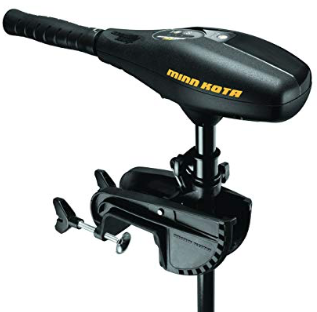
Minn Kota Traxxis 55: Guide
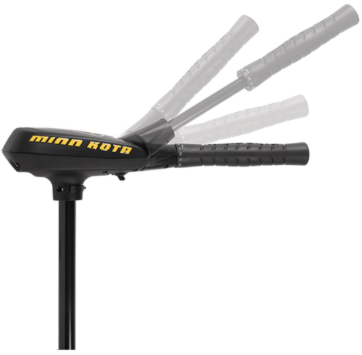
Please Note: First, as an Amazon Associate I earn from qualifying purchases.
Welcome to KFC’s review of the Minn Kota Traxxis 55! This post contains everything you need to know about the Minn Kota Traxxis 55 for purposes of deciding whether to make it a part of your kayak fishing gear collection. To make sure we present all of this article’s information in an easy to follow manner, we’ve broken this article into a number of separate categories. We begin by going over some of the basics about trolling motors – What are they? What are the different styles? Why is why style more appropriate than another and when? How are they powered? And so on.
After that, we have written a short “how to” checklist that will walk you step by step through the process of installing and using a Minn Kota Traxxis 55 (or a similar transom mount trolling motor). We then move into a discussion of some of the top 3 features that you should look for in any transom mount trolling motor. We go into detail on each of the top 3 features, explain why the are important individually and why the combination of the 3 will set you apart from the other kayak fishermen on the water!
We’ve included a link to the Minn Kota Traxxis 55 product page so that you can take a look at some of the additional specifications and images for the product. After that, we’ve added a short story about our own experiences with this particular model of transom mount kayak trolling motor – hopefully you enjoy learning from our experiences!
Minn Kota Traxxis 55: The Basics
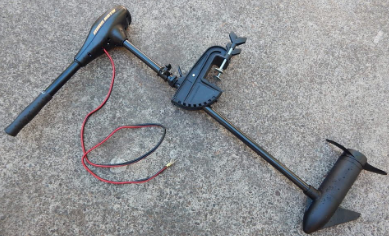
Please note: This post contains affiliate links. An affiliate link means that we may earn advertising/referral fees if you make a purchase through our links.
Shortcut to the Minn Kota Traxxis 55 Review
The image above is a great example of a basic trolling motor setup. If you hear someone talking about an electric kayak – odds are they are talking about a fishing kayak that has been outfitted with a kayak trolling motor. These kids of motors come in two predominant styles. The first is known as a “transom” mount and the second is known as a “bow” mount. A transom mount (like the Minn Kota Traxxis 55) will attach along the side of your kayak to a transom (a flat surface). A bow mount will be located in the front and middle of your kayak.
These kinds of motors come in a variety of engine sizes. Their size is typically referred to in pounds of thrust. We commonly see 25 – 80 pound models for fishing kayaks. The larger the size, the more thrust (speed and power) your motor can provide. Oftentimes, the more thrust provided, the heavier the motor is. They typically range from 20 – 50 pounds, though there are certainly exceptions.
These kinds of kayak fishing accessories are commonly paired with other pieces of kayak fishing gear. One common pairing is with the Minn Kota Talon – a form of kayak anchor or even kayak outriggers (learn about the Best Kayak Outrigger). They are also fairly intuitive, though you’ll want to be sure to follow the manufacturer’s guide when making the installation and for tips of using the motor safely!
How to Use Properly
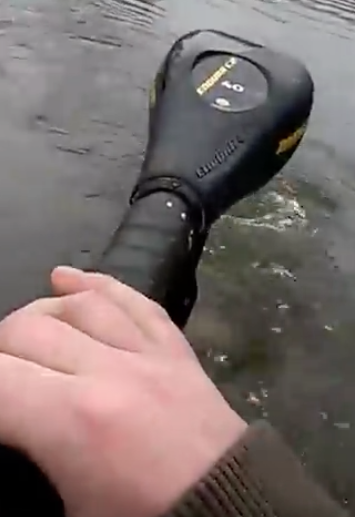
Above we mention that kayak trolling motors are fairly intuitive. In the image included right before this section, you can see a kayak fisherman’s hand upon the throttle of a trolling motor. To provide power, all you do is rotate your hand to the right. In this way it is very similar to a dirt bike or motorcycle. Of course, there are also Foot Control Trolling Motors which, you guessed it, can be controlled by your feet rather than your hand!
While each kayak trolling motor is going to be somewhat different from the next, the short checklist below will walk you through the highlights that are common among the numerous models. Of course, you should check your specific model’s user’s manual to be sure that you are aware of any specifics of the particular model, but the KFC checklist will be perfect for generally familiarizing you with installation and use!

- Begin by reading the user guide.
- Remove the trolling motor from its box.
- Most trolling motors come with the main pieces already put together, this means that all you need to do is attach the head (the top piece) to the handle, then proceed to the next instruction.
- Identify the handle and head.
- Place the handle and head atop the shaft.
- We like to wiggle back and forth and pull to make sure your connection is solid.
- Connect the mounting bracket to the middle of the shaft (this bracket is used to connect the motor to the motor mount).
- Attach the propeller to the metal casing, and the now connected motor with propeller to the bottom of the shaft.
- Your kayak motor mount should already be installed at this point. If it is not, you should go ahead and install it.
- Attach the mounting bracket to the motor mount.
- Adjust the height of the trolling motor.
- Do not allow the motor to lay too low in the water or too close to the surface – it will perform best when the motor head is between 2.5 and 3.5 feet below the surface of the water.
- Too shallow and you won’t get good propulsion or direction! Too deep and you risk running aground and snapping the shaft! A snapped shaft is never good!
- Be sure to practice forward, reverse, and side to side maneuvering.
- To go left, direct the throttle (or ruddering system) to the right! Vice versa to go right! Easy enough, right?
Minn Kota Traxxis 55: Important Features
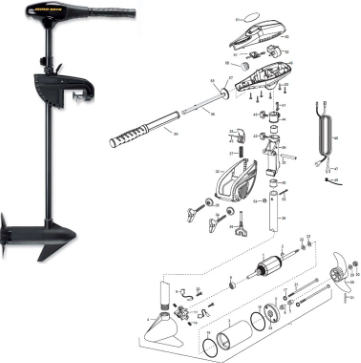
This article focuses on the Minn Kota Traxxis 55 (and other very similar types of transom mount trolling motors). Just because we have focused on this particular model and manufacturer (Minn Kota) we do not mean to suggest that there aren’t other high quality products available from different sources. This is great for kayak fishermen because the increased supply brings down the cost of kayak trolling motors (they used to be much more expensive)!
Regardless of what manufacturer you decide to go with, there is one rule of thumb that we need to suggest to you: You should make sure that your particular model of trolling motor contains each of the top 3 features that we highlight below. Sure, a model that contains 1 or 2 of these features is good, but the combination of the 3 will really set you and your trolling motor apart. Let’s take a detailed look at each feature and thoroughly discuss its importance to the kayak fisherman!

Large and Reliable Motor. You need a motor that is properly sized for kayak fishing. These kinds of trolling motors typically come in sizes from 25 pounds of thrust to 80 pounds of thrust. A kayak fisherman will likely need a motor capable of at least 40, but not more than 55, pounds of thrust. This size is sufficient to battle against large waves, wakes, currents and winds. Too small? You’ll be at the mercy of the currents (whether water or wind) and, more dangerously, other boats! Here is a zoomed in image of a common propeller, rudder, shaft and casing!
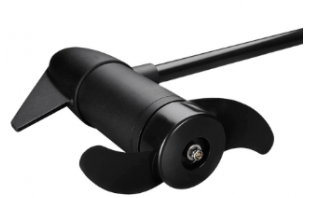
Durable Mounting Bracket. This is where the rubber meets the road, at least so to speak! The mounting bracket is where the trolling motor connects to the kayak motor mount (which is the piece the serves as the connection of the kayak to the motor). We were amazed how many models of kayak trolling motor omit the mounting bracket from their design. How does the manufacturer suggest mounting the motor to the kayak if they don’t include a bracket?! Here is a zoomed in image of a mounting bracket (below) to give you an idea of what they typically look like:
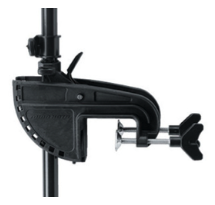
The two “screw down” pieces have ergonomic handles and lay flat compression points. It is our experience that this kind of design is the “best” way to assure yourself of a sound connection without needing special tools. This type of design also allows you to remove the trolling motor if you don’t think you are going to need it. But do us a favor, make sure to check the forecast and learn how to assess weather conditions before you venture out without it!
Visual Battery. Remember, these motors are battery powered. The charge won’t last forever, but how do you know how much is remaining? Yes, you could “risk” it by setting a period of time and estimating how much battery you have remaining, but you never know how hard the motor is actually working. Without knowing that, you don’t know how quickly the battery is depleting – this could leave you stranded far from the safety of the shore. Luckily, there is a way to prevent this!
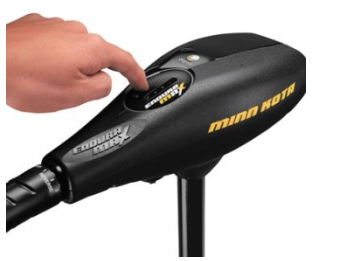
Find a motor with a digital display capable of measuring battery life. Yes, these models may be a little more expensive, they are well worth it! Notice that the display on the model depicted above is located at the head of the unit, right near the electric motor’s handle and within easy observation by the kayak fisherman! Some are purely visual (green, yellow and red bars) while other emit beeping or some other kind of warning sound!
Buy the Minn Kota Traxxis 55
(Commissions Earned)
The Minn Kota Traxxis 55 (or the Minn Kota Endure C2 55 – depending on the size you need) is one of our favorites. Not only does it have all of the features from our Top 3 List, it is offered by a high quality manufacturer in Minn Kota who has been making high quality watercraft products for decades. It has a well designed 6″ handle that adjusts to any number of positions (or collapses in on itself – a/k/a it is “telescopic”).
This particular model can generate 55 pounds of thrust. While anywhere above 40 pounds is acceptable, a little extra power on the water is never a bad thing. This trolling motor comes in variable shaft lengths (36″ and 42″). We like the variability because it allows for this model to “fit” different sized fishing kayaks. It also means that the motor can be effective in predominantly shallower (or predominantly deeper) depths.
This model weighs roughly 25 – 30 pounds. This lighter weight is nice because, unlike bow mount trolling motors, this model is a transom mount style (mounts to the side of your kayak). It doesn’t take a rocket scientist to figure out that if it was too heavy, it could cause the kayak to lean over to one side – causing you to constantly drift of course while under power and generally making the motor and propeller work “harder” than it needs to (which also drains the battery).
My Experience

I will tell you that I don’t always use a kayak trolling motor while I am kayak fishing. Sometimes I like to use good old fashioned paddles to navigate from location to location on the water. However, if I want to reduce my fatigue (paddling is hard!) and move along the water with greater ease, then I am using a Minn Kota Traxxis 55 or the Minn Kota Endure C2 55.
I have used my model for 3 (nearly 4) seasons. I am happy to report that it performs just as well today as it did when I brought it out of its box. Be careful, however, and be sure to take into account the type of water that you’ll be fishing in. For example, I kayak fish (most of the time) in freshwater. I would need to look into other models of kayak motor if I predominantly kayak fished in the ocean, as saltwater can cause damage to metals and electronics!
Finally, 55 pounds of thrust seems to be a really nice “sweet spot”. It is powerful enough to move me and my kayak from location to location, while being lightweight enough to keep me from tiring while I am taking it from my vehicle to the water’s edge (where I usually connect the motor to the kayak). Sure, a little extra power would be great, but I like the ease of maneuverability of the lighter weight model. 55 pounds still packs quite the punch!
MINN KOTA TRAXXIS 55: CONCLUSION

We hope this post has proven to be a helpful resource in terms of helping you learn all about the Minn Kota Traxxis 55 in an effort to decide whether it is the right transom mount trolling motor for you. If you’ve made it to this point in the article and you still have some questions about the Minn Kota Traxxis 55, we would like to post them on the Comments board below!
KFC’s Comments board is one of the internet’s foremost resources for serving as an open forum among kayak fishing enthusiast. Odds are, if we don’t know the answer to your question, one of your fellow readers will! Be love hearing from the kayak fishing community and we read and reply to every single comment that is posted to the board!
Comments
Have you ever seen anyone using the Minn Kota Traxxis 55? Perhaps you have personal experience with it or another type of transom mount kayak trolling motor? How did you manage the installation? Have you found that it is easy to maintain? What kind of thrust is your model capable of generating and is it enough for the body of water that you tpicallly fish on? Have you learned of any tips or tricks that you’d like to share with this kayak fishing community?
Please share your story with us by posting below! We’d love to hear from, and interact with, you! See you on the water!

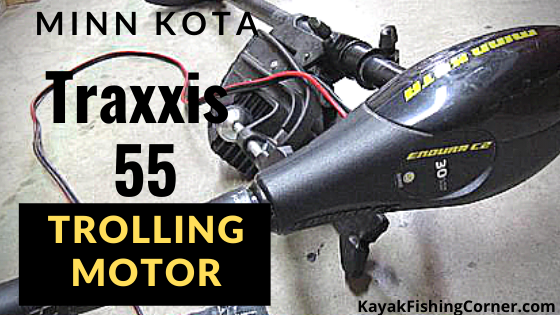

Can I use this kind of trolling motor while I’m kayak fishing in a river?
Hi Jordan –
No doubt about it! I typically use it in the lake, but a friend of mine exclusively uses his in a river nearby his home. It puts up a pretty good fight even against relatively swift currents. The main thing he likes about it is that it allows him to navigate around problematic sandbars near the shore (they develop during certain times of the year).
– DS